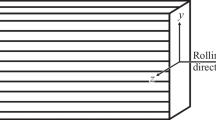With the example of Aramid fibers, it is shown that the model of acumulation of fiber breaks in composites cannot explain their observed tensile strength exceeding that of unimpregnated Aramid fibers. The model of longitudinal splitting of fibers proposed by Wagner, with account of fiber-matrix interaction, is based on the idea that the break of fibers begins at great strains owing to their interaction with the matrix. This model better describes the failure of composites with anisotropic fibers having an internal fibrillar structure. The results obtained can also be used for other types of fibers with an internal microstructure.






Similar content being viewed by others
References
J. K. Fink, High-Performance Polymers.-William Andrew Inc, Austria, Р. 301-320 (2014).
Hung Man Yang, Module in Materials Science and Materials Engineering, Comprehensive Composite Materials II. Vol. 1, Elsevier Inc., (2018).
M. Ertekin, “Fiber technology for fiber-reinforced composites, aramid fibers,” Compos. Sci. Eng., 7, 153-167 (2017).
K. E. Perepelkin, “Modern chemical fibers and prospects of their application in the textile industry,” Ros. Khim. Zhurn., XLVI, No. 1, 31-47 (2002).
S. V. Kotomin, “Polymer molecular composites - new history,” J. Thermoplast. Compos. Mater., 26, No. 9, 91-108 (2013).
Fiber Fracture. eds. M. Elices and J. Llorca. Elsevier Sci. Ltd., Oxford OX5 IGB, UK (2002).
S. V. Kotomin and N. N. Avdeev, “Compaction and consolidation of Aramid and composite fibers. 2. Consolidation of composite fibers,” Mech. Compos. Mater., 39, No. 1, 71-76 (2003).
S. V. Kotomin and N. N. Avdeev, “Compaction and consolidation of aramid and composite fibers. 1. Compaction of Aramid fibers,” Mech. Compos. Mater., 38, No. 5, 461-470 (2002).
S. V. Kotomin, A. A. Basharov, V. G. Bova, and E. M. Sapozhnikov, “Realization of the strength of Armos fibers with different acidity in epoxy plastics,” Fiber Chem., 28, No. 1, 48-49 (1996).
S. Jackson and S. Sutanu, “Characterization of Kevlar fiber and its composites: A review,” Mater. Today, No. 2, 1381-1387 (2015)
A. F. Ermolenko, “Checking the strength of fibrous reinforcing materials used to make products out of composites by the method of continuos winding,” Mech. Compos. Mater., 26, No. 5, 622-627 (1991).
G. L. Gorynin, Y. Nemirovskii, and A. Vlasko, “Multiscale simulation of thermal stresses in 3D periodic anisotropic bodies,” Proc. of the HEPCM 2017: AIP Conf. Proc. 030111 (2017).
P. V. Mikheev, et al., “The effect of properties of a matrix on tensile strength of organoplastics,” Dokl. Akad. Nauk SSSR, 291, No. 5, 1120-1122 (1986).
Termonia et al., “Theoretical study of the influence of the molecular weight on the maximum tensile strength of polymer fibers,” Macromolecules, 18, No. 11, 2246-2252 (1985).
A. F. Ermolenko, “Model of destruction of a unidirectional fibrous composite with an elastic matrix,” Mech. Compos. Mater., No. 2, 247-256 (1985).
L. Jr. Mishnaevsky and P. Brøndsted, “Micromechanisms of damage in unidirectional fiber reinforced composites with polymer matrix: 3D computational analysis,” Compos. Sci. Technol., 699, Nos. 7-8, 1036-1044 (2009).
L. Jr. Mishnaevsky and P. Brøndsted, “Micromechanical modeling of damage and fracture of unidirectional fiber reinforced composites,” Computat. Mater. Sci., 44, No. 4, 1351-1359 (2009).
L. V. Kompaniets et al. “Aramid fiber strength and its realization in threads and microplastics,” Mech. Compos. Mater., 19, No. 3, 277-280 (1983).
P. V. Mikheev et al., “Modeling the influence of properties of a matrix on strength of unidirectional fibrous composite materials,” Proc. 2nd ICTMAA, Wrexham, June 11-13, 118-122 (2012).
A. Ya. Gorenberg, Research of deformation and destruction of polymeric matrixes, fibers and composites by electronmicroscopic methods, Abstract of Thesis of cand. of physical and mathematical sciences [in Russian], M, IKh. F RAN (2008).
H. D. Wagner, S. L. Phoenix, and P. A. Sohwartz, “Study of statistical variability in the strength of single aramid filaments,” J. Compos. Mater., 18, No. 4, 332-338 (1984).
H. D. Wagner, “A model for longitudinal splitting from surface defects in anisotropic filaments,” J. Mater. Sci. Letter, 5, No. 2, 229-230 (1986).
T. Devesh, C. Fangping, and F. R. Jones, “The effect of matrix plasticity on the stress fields in a single filament composite and the value of interfacial shear strength obtained from the fragmentation test,” Proc. Roy. Soc., March, 621-653 (1996).
P. V.. Mikheyev, A. А. Berlin, E. S. Zelenskii, and A. M. Kuperman, “Physicochemical processes in converters of energy,” Sb/ Nauch. Trud., Izd MFTI, 94-97 (1987).
P. V. Mikheyev, Failure mechanisms of unidirectional fibrous polymer composites, Abstract of Thesis of cand. of physical and mathematical sciences [in Russian], M (1987).
S. L. Bazhenov, A. А. Berlin, A. A. Kulkov, and V. G. Oshmyan, Polymerr Composite Materials. Strength and Technology [in Russian], Dolgoprud. Izd., “Intellekt” (2010).
S. Mahesha, J. C. Hananb, E. Üstündagb, and I. J. Beyerleinc, “Shear-lag model for a single fiber metal matrix composite with an elasto-plastic matrix and a slipping interface,” Int. J. Solids and Struct., 41, No. 15, 4197-4218 (2004).
W. Na, G. Lee, M. Sung Heung, and Yu. N. H. Woong-Ryeol, “Prediction of the tensile strength of unidirectional carbon fiber composites considering the interfacial shear strength,” Compos. Struct. 168, No. 5, 92-103 (2017).
P. L. S. Ned, J. M. Silvestre, and T. Pinho, “Stress redistribution around clusters of broken fibers in a composite,” Compos. Struct., 168, No. 5, 226-233 (2017).
Acknowledgement
The reported study was funded by RFBR according to the research project No. 18-47-860015.
Author information
Authors and Affiliations
Corresponding author
Additional information
Translated from Mekhanika Kompozitnykh Materialov, Vol. 55, No. 2, pp. 379-388, March-April, 2019.
Rights and permissions
About this article
Cite this article
Mikheyev, P.V., Berlin, A.A. Effect of Splitting of Polymer Fibers on the Strength of Unidirectional Composites. Mech Compos Mater 55, 267–274 (2019). https://doi.org/10.1007/s11029-019-09810-3
Received:
Revised:
Published:
Issue Date:
DOI: https://doi.org/10.1007/s11029-019-09810-3



